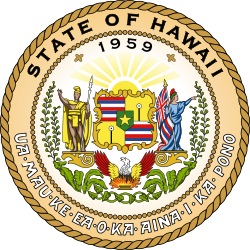This article needs additional citations for verification .(May 2017) |
| 29th Hawaii State Legislature | |||
|---|---|---|---|
| |||
 | |||
| Overview | |||
| Legislative body | Hawaii State Legislature | ||
| Jurisdiction | Hawaii | ||
| Term | November 10, 2016 – November 6, 2018 | ||
| Senate | |||
| Members | 25 | ||
| President | Ron Kouchi (D) | ||
| Vice President | Michelle Kidani (D) | ||
| Majority Leader | J. Kalani English | ||
| Party control | Democratic | ||
| House of Representatives | |||
| Members | 51 | ||
| Speaker | Joseph M. Souki (D) until May 4, 2017 Scott Saiki (D) from May 4, 2017 | ||
| Vice Speaker | John Mizuno (D) | ||
| Minority Leader | Beth Fukumoto (R) until February 2, 2017 Andria Tupola (R), from February 2, 2017 | ||
| Party control | Democratic | ||
| Sessions | |||
| |||
The Twenty Ninth Hawaii State Legislature, consisting of the Hawaii House of Representatives and the Hawaii Senate, was constituted in the U.S. state of Hawaii from November 10, 2016, to November 6, 2018, during the final two years of David Ige's first term as governor. The 2016 elections gave the Democrats an even larger majority in both legislative bodies, with the losses of one Republican representative and lone Republican senator Sam Slom.
Contents
- Major events
- Major Legislation
- Enacted
- Proposed
- Vetoed
- Party Summary
- Senate
- House of Representatives
- Leadership
- Senate 2
- House of Representatives 2
- Members
- Senate 3
- References
On March 22, 2017, former House Minority Leader Beth Fukumoto announced she would leave the Republican Party and seek membership in the Democratic Party. [1] This lowered Republican membership in the Hawaii House of Representatives to 5 against 45 Democrats.